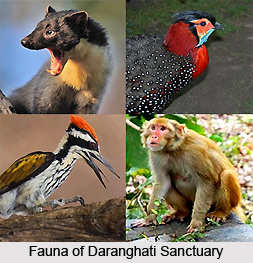Wildlife Sanctuaries In Himachal Pradesh

National Parks In Himachal Pradesh
हिमाचल प्रदेश के राष्ट्रीय उद्यान
हिमाचल प्रदेश में वनस्पतियों और जीवों की विविधता अत्यधिक है। यहाँ के कुछ प्रमुख राष्ट्रीय उद्यान और उनकी विशेषताएँ निम्नलिखित हैं:
| क्र.सं. | राष्ट्रीय उद्यान | क्षेत्रफल (किमी²) | विशेषताएँ |
|---|---|---|---|
| 1 | ग्रेट हिमालयन नेशनल पार्क | 1,171 | हाल ही में यूनेस्को द्वारा विश्व धरोहर स्थल घोषित किया गया है। यह पार्क उच्च पर्वतीय पारिस्थितिक तंत्र का प्रतिनिधित्व करता है और इसमें विभिन्न प्रकार के पौधों और जीवों की प्रजातियाँ पाई जाती हैं। |
| 2 | पिन वैली नेशनल पार्क | 675 | यह पार्क विशेष रूप से अपने समृद्ध वनस्पति और जीवों के लिए जाना जाता है। इसमें बर्फीले क्षेत्र और घास के मैदान शामिल हैं। |
| 3 | खीरगंगा नेशनल पार्क | 705 | यह पार्क प्राकृतिक गर्म पानी के स्रोतों और सुरम्य पहाड़ी दृश्यों के लिए प्रसिद्ध है। |
| 4 | इंद्रकिला नेशनल पार्क | 94 | यह पार्क अपने असामान्य उच्च पर्वतीय वातावरण और वनस्पतियों के लिए जाना जाता है। |
| 5 | सिंबलबारा नेशनल पार्क | 27.88 | यह पार्क पक्षियों और वन्य जीवों की प्रजातियों की विविधता के लिए जाना जाता है। |
Also Read This: National Parks in Himachal Pradesh
लोकप्रिय वन्यजीव अभ्यारण्यों में शामिल हैं:
- कालाटोप-खजियार अभ्यारण्य
- सैंज घाटी वन्यजीव अभ्यारण्य
- गोबिंद सागर अभ्यारण्य
आगामी विकास
- गौ अभ्यारण्य: जिला सिरमौर में विकसित किया जाएगा।
ये राष्ट्रीय उद्यान और वन्यजीव अभ्यारण्य हिमाचल प्रदेश की जैव विविधता को संरक्षित करने में महत्वपूर्ण भूमिका निभाते हैं और पर्यटकों को प्राकृतिक सुंदरता और वन्य जीवन का आनंद लेने का अवसर प्रदान करते हैं।
Wildlife Sanctuaries in Himachal Pradesh
Total Area: 5964.9731 Km²
Notes on Wildlife Sanctuaries:
- Legal Protection: Wildlife sanctuaries are protected under sections 18-26 of the Wildlife (Protection) Act, 1972. Any destruction or exploitation of wildlife or habitat within these areas is prohibited.
- Public Access: Visitors are allowed to experience and enjoy the wilderness, but activities that could harm the wildlife or habitat are restricted.
- Biodiversity: These sanctuaries are crucial for the conservation of various species of flora and fauna, including some endangered and endemic species.
These protected areas play a significant role in maintaining ecological balance, conserving wildlife, and providing opportunities for eco-tourism.
Wildlife Sanctuaries are crucial for the conservation of wildlife and their habitats, providing protection and a natural environment for various species. Established under sections 18-26 of the Wildlife (Protection) Act, 1972, these areas are carefully managed and monitored to ensure that wildlife is preserved and their habitats are maintained. The boundaries of Wildlife Sanctuaries, similar to National Parks, are fixed and cannot be altered without a resolution from the State Legislature.
Here’s a summary of the Wildlife Sanctuaries in the state, including their locations and areas:
| Sr. No. | Sanctuary | District | Area (Km²) |
|---|---|---|---|
| 1 | Bandli | Mandi | 32.11 |
| 2 | Chail | Solan | 16 |
| 3 | Chandra Tal | Lahaul & Spiti | 38.56 + (11.53 for Consideration) |
| 4 | Churdhar | Sirmour | 55.52 |
| 5 | Daranghati I & II | Shimla | 171.50 |
| 6 | Dhauladhar | Kangra | 982.86 |
| 7 | Gamgul-Siyabehi | Chamba | 108.40 |
| 8 | Kais | Kullu | 12.61 |
| 9 | Kalatop-Khajjiar | Chamba | 17.17 |
| 10 | Kanawar | Kullu | 107.29 |
| 11 | Khokhan | Kullu | 14.94 |
| 12 | Kibber | Lahaul & Spiti | 2220.12 |
| 13 | Kugti | Chamba | 405.49 |
| 14 | Lipa Asrang | Kinnaur | 31 |
| 15 | Majathal | Solan | 30.86 |
| 16 | Manali | Kullu | 29 |
| 17 | Nargu | Mandi | 132.37 |
| 18 | Pong Dam Lake | Kangra | 207.59 |
| 19 | Rakchham-Chitkul | Kinnaur | 304 |
| 20 | Renuka ji | Sirmour | 3.87 |
| 21 | Rupi-Bhaba | Kinnaur | 503 |
| 22 | Sechu-Tuan Nalla | Chamba | 390.29 |
| 23 | Shikari Devi | Mandi | 29.94 |
| 24 | Shimla Water Catchment | Shimla | 10 |
| 25 | Talra | Shimla | 46.48 |
| 26 | Tundah | Chamba | 64 |
| Total Area | 5964.97 |
These sanctuaries offer a great opportunity for visitors to experience the natural beauty and biodiversity of the state, while also contributing to the conservation of its wildlife.
Wildlife Sanctuaries of Himachal Pradesh: A Comprehensive Overview
Himachal Pradesh is renowned for its diverse wildlife sanctuaries, each offering unique insights into the region’s natural heritage. This guide highlights some of the major sanctuaries, focusing on their key features, locations, and wildlife.
Renuka Wildlife Sanctuary
- Location: Near Renuka Lake, Sirmaur District
- Area: 402 hectares (plus 300-hectare buffer zone)
- Features: Dense deciduous forests, freshwater springs
- Wildlife: Leopard, Sambar, Spotted Deer, Black Bear, Porcupine
- Birds: Red Jungle Fowl, Khaleej Pheasant, Blue Jay, Scarlet Minivet
- Additional: Mini zoo for rescued animals; accessible from Nahan and Dadahu
Churdhar Wildlife Sanctuary
- Location: Sirmaur District
- Area: 56.16 square kilometers
- Features: Mixed coniferous forests, Kharu Oaks
- Wildlife: Leopard, Himalayan Black Bear, Musk Deer, Ghoral
- Birds: Monal Pheasant, Khaleej Pheasant, Red Jungle Fowl
- Additional: Accessible from Nohradhar and Chopal; features trekking trails

Daranghati Wildlife Sanctuary
- Location: Rampur and Sarahan regions, Shimla District
- Area: 171 square kilometers
- Features: Diverse habitats including alpine and temperate forests
- Wildlife: Himalayan Brown Bear, Himalayan Musk Deer, Serow, Blue Sheep
- Birds: Western Tragopan, Koklass Pheasant, Cheer Pheasant
- Additional: Accessible via Rampur and Mashnoo; includes the historic Old Hindustan-Tibet Road

Kanwar Wildlife Sanctuary
- Location: Parvati Valley, Kullu District
- Area: 107 square kilometers
- Features: Diverse landscape with forests of Oak, Deodar, and alpine pastures
- Wildlife: Himalayan Thar, Black Bear, Brown Bear, Musk Deer, Snow Leopard
- Birds: Khaleej Pheasant, Monal Pheasant, Cheer Pheasant, Western Tragopan
- Additional: Accessible from Kasol or Manikaran
Rupi-Bhawa Wildlife Sanctuary
- Location: Nichar subdivision, Kinnaur District
- Area: 503 square kilometers
- Features: Alpine pastures, high-altitude treks
- Wildlife: Snow Leopard, Brown Bear, Black Bear, Musk Deer, Blue Sheep
- Birds: Western Tragopan, Monal Pheasant, Koklass Pheasant, Chukar Partridge
- Additional: Accessible from Wangtu and Chaura; connects with Great Himalayan and Pin Valley National Parks

Rakchham-Chitkul Wildlife Sanctuary
- Location: Sangla Valley, Kinnaur District
- Area: 304 square kilometers
- Features: High-altitude habitats, alpine forests
- Wildlife: Snow Leopard, Brown Bear, Black Bear, Himalayan Thar
- Birds: Western Tragopan, Monal Pheasant, Koklass Pheasant, Cheer Pheasant
- Additional: Accessible from Karchham; offers adventurous treks
Majathal Wildlife Sanctuary
- Location: Solan and Shimla Districts
- Area: 31 square kilometers
- Features: Hilly terrain with Ban Oak and sparse pine forests
- Wildlife: Leopard, Ghoral, Barking Deer
- Birds: Cheer Pheasant, Khaleej Pheasant, Red Jungle Fowl
- Additional: Easily reachable from Shimla and Solan
Chail Wildlife Sanctuary
- Location: Around Chail, Shimla District
- Area: 16 square kilometers
- Features: Deodar and oak forests with grasslands
- Wildlife: Sambhar, Goral, Barking Deer
- Birds: Cheer Pheasant, Chukor, Peafowl
- Additional: Includes a Cheer Pheasant Breeding Centre; accessible from Shimla
Manali Wildlife Sanctuary
- Location: Outskirts of Manali, Kullu District
- Area: 29 square kilometers
- Features: Dense deodar and maple forests
- Wildlife: Black Bear, Leopard, Musk Deer, Barking Deer
- Birds: Monal Pheasant, Khaleej Pheasant
- Additional: Includes highlands and glaciers; accessible from Hadimba Temple
Kibber Wildlife Sanctuary
- Location: Spiti Valley, Kaza region
- Area: 2,220 square kilometers
- Features: Cold desert environment, high altitudes
- Wildlife: Snow Leopard, Ibex, Blue Sheep, Tibetan Wolf
- Birds: Himalayan Snowcock, Golden Eagle, Snow Pigeon
- Additional: Largest sanctuary in Himachal Pradesh; offers views of Spiti River and high peaks
Bandli Wildlife Sanctuary
- Location: Mandi district, Himachal Pradesh, India
- Coordinates: 31.450°N 76.905°E
- Area: 41.32 km² (15.95 sq mi)
- Established: 1962
- Governing Body: Ministry of Environment, Forest and Climate Change
Description: Bandli Wildlife Sanctuary, located approximately seven kilometers from Sundar Nagar, Himachal Pradesh, spans 41.32 square kilometers. The sanctuary is distinguished by its steep slopes, diverse grasslands, and the essential Seri Khad stream, which sustains its unique ecosystem. The terrain supports a variety of plant and animal species, making it a critical conservation area in the region.
Fauna: The sanctuary is home to a rich array of bird species, including the globally vulnerable Cheer pheasant (Catreus wallichii), Kalij pheasant (Lophura leucomelanos), Indian peafowl (Pavo cristatus), and red junglefowl (Gallus gallus). Other notable avian species include the Himalayan swiftlet, Long-tailed shrike, Blue-throated Barbet, Red-billed Blue Magpie, and Fire-capped Tit. Mammals in the sanctuary include the elusive Snow leopard (Panthera uncia), Goral (Naemorhedus goral), Barking deer (Muntiacus muntjak), Hanuman langur (Semnopithecus entellus), Indian fox (Vulpes bengalensis), and Black bear (Ursus thibetanus).
Conservation Concerns: A Cumulative Environmental Impact Assessment (CEIA) has identified Bandli Wildlife Sanctuary as a critical zone for fish fauna protection. The assessment recommends designating it as a “no-hydro project zone” to preserve its aquatic biodiversity and prevent habitat disruption.
Additional Information: The sanctuary’s diverse topography and rich grasslands make it an important site for wildlife conservation and environmental research. Its varied terrain supports a broad range of flora and fauna, contributing to its significance as a protected area. Bandli Wildlife Sanctuary continues to be a valuable location for scientific studies and conservation efforts.
Chandratal Wildlife Sanctuary
- Location: Lahaul and Spiti district, Himachal Pradesh, India
- Coordinates: Approximate boundaries provided
- Area: Varies by region (specific details can be added if known)
- Established: Date not specified
Description: The Chandratal Wildlife Sanctuary encompasses the area around Chandratal Lake, situated in the Lahaul and Spiti district. It is characterized by its high-altitude terrain, steep slopes, and unique alpine ecosystem. The sanctuary’s boundaries extend along ridges and rivers, creating a distinct habitat for its flora and fauna.
Fauna: The sanctuary supports a range of wildlife, including the elusive Snow leopard (Panthera uncia) and the Himalayan Tahr (Hemitragus jemlahicus). Other notable species include the Blue sheep (Pseudois nayaur), which is adapted to the rugged high-altitude environment.
Conservation Concerns: Due to its delicate high-altitude ecosystem, the sanctuary is subject to conservation efforts aimed at preserving its unique alpine flora and fauna. Details on specific conservation concerns and measures can be added based on further research.
Additional Information: The sanctuary’s landscape is marked by the pristine Chandratal Lake and surrounding alpine meadows, making it a vital area for preserving high-altitude biodiversity.
Shikari Devi Wildlife Sanctuary
- Location: Himalayan foothills, Himachal Pradesh, India
- Coordinates: Not specified
- Area: Approximately 60 km² (varies)
- Established: 1962
Description: Shikari Devi Wildlife Sanctuary is located in the Himalayan foothills and covers a significant area of mixed forest terrain. It is known for its dense forest cover and rich biodiversity, making it a popular destination for wildlife enthusiasts.
Fauna: The sanctuary is home to a variety of species, including Goral (Naemorhedus goral), Black bear (Ursus thibetanus), Musk deer (Moschus spp.), and the Monal (Lophophorus impejanus). It also supports diverse bird species and other mammals.
Conservation Concerns: Conservation efforts in Shikari Devi focus on protecting its rich biodiversity and forest habitat from threats such as poaching and habitat degradation.
Additional Information: The sanctuary’s lush forested areas and diverse wildlife make it an important site for both conservation and eco-tourism.
Nargu Wildlife Sanctuary
- Location: Mandi district, Himachal Pradesh, India
- Coordinates: North 32°06′49″N 76°56′35″E to South 31°48′42″N 77°02′41″E
- Area: Originally 278 km², reduced to 132.37 km² (51.11 sq mi) in 2013
- Established: 1999
Description: Nargu Wildlife Sanctuary is situated on the east side of the Uhl River and is characterized by alpine forests and rugged terrain. The sanctuary was established to protect the diverse flora and fauna of the region.
Fauna: The sanctuary is home to a range of mammals, including the Common leopard (Panthera pardus), Barking deer (Muntiacus muntjak), Black bear (Ursus thibetanus), and Jackal (Canis aureus). Key bird species include the Himalayan monal (Lophophorus impejanus) and White-crested kalij (Lophura leucomelanos).
Conservation Concerns: Efforts are focused on preserving the sanctuary’s alpine forests and protecting its wildlife from threats such as habitat loss and poaching.
Additional Information: The sanctuary’s diverse flora includes deodar and fir forests, while its fauna includes both common and rare species, making it a significant area for wildlife conservation.
Pong Dam Lake Wildlife Sanctuary
- Location: Kangra district, Himachal Pradesh, India
- Coordinates: Approximate coordinates available
- Area: 207 km² (including the reservoir)
- Established: 1975
Description: Pong Dam Lake Wildlife Sanctuary surrounds the Pong Dam Reservoir, the highest earth-fill dam in India. The wetland area is crucial for a variety of bird species and is noted for its significant bird populations.
Fauna: The sanctuary is renowned for its birdlife, with over 420 species recorded, including migratory birds like Bar-headed geese (Anser indicus). Mammals in the sanctuary include the Common leopard (Panthera pardus) and Wild boar (Sus scrofa). Reptiles and amphibians also inhabit the area.
Conservation Concerns: The sanctuary’s status as a Ramsar site highlights its importance for global wetland conservation. Efforts are focused on maintaining the habitat for migratory birds and other wildlife.
Additional Information: The sanctuary’s diverse avifauna and its role as a critical wetland ecosystem make it an important site for both conservation and bird-watching tourism.
Talra Wildlife Sanctuary
- Location: Shimla district, Himachal Pradesh, India
- Coordinates: Approximate coordinates available
- Area: 40 km²
- Established: 1962
Description: Talra Wildlife Sanctuary is situated in the Shimla district and is characterized by its dense forests and high-altitude terrain. The sanctuary is an eco-sensitive zone with rich biodiversity.
Fauna: The sanctuary is home to Snow Leopard (Panthera uncia), Barking deer (Muntiacus muntjak), and a variety of other mammals such as the Himalayan Palm Civet (Paguma larvata). Bird species include the Eurasian Sparrowhawk (Accipiter nisus) and Flying Squirrel (Petaurista spp.).
Conservation Concerns: The sanctuary’s location in an eco-sensitive zone requires careful management to protect its delicate high-altitude environment from human impact.
Additional Information: Talra Wildlife Sanctuary is known for its dense forests and significant wildlife, contributing to its status as a protected area.
Khokhan Wildlife Sanctuary
- Location: Kullu district, Himachal Pradesh, India
- Coordinates: Approximate coordinates available
- Area: 14.2 km²
- Established: 1954
Description: Khokhan Wildlife Sanctuary is situated near Kullu and is noted for its diverse mammal and reptile populations. It is particularly known for its habitat of the endangered Himalayan Black Bear (Ursus thibetanus).
Fauna: The sanctuary supports species such as the Himalayan Tahr (Hemitragus jemlahicus), Barking Deer (Muntiacus muntjak), and various birds including the Monal (Lophophorus impejanus) and Khaleej Pheasant (Lophura leucomelanos).
Conservation Concerns: Efforts are focused on preserving the habitat of endangered species and managing the sanctuary’s ecosystem to support its diverse wildlife.
Additional Information: The sanctuary’s proximity to Kullu makes it accessible for visitors, adding to its significance for both conservation and tourism.
Kalatop Khajjiar Sanctuary
- Location: Chamba district, Himachal Pradesh, India
- Coordinates: 32.55°N 76.01°E
- Area: 30.69 km²
- Established: Date not specified
Description: Kalatop Khajjiar Sanctuary is located in the Chamba district and is known for its dense deodar and fir forests. The sanctuary offers trekking trails and scenic views, contributing to its appeal for visitors.
Fauna: The sanctuary is home to species such as the Himalayan Black Bear (Ursus thibetanus), Ghoral (Naemorhedus goral), and the Himalayan Monal (Lophophorus impejanus). Bird species include the Western Tragopan (Tragopan melanocephalus) and Kaleej Pheasant (Lophura leucomelanos).
Conservation Concerns: Conservation efforts focus on maintaining the sanctuary’s forest habitat and protecting its wildlife from potential threats.
Additional Information: The sanctuary’s diverse flora and fauna, along with its trekking opportunities, make it a popular destination for eco-tourism and wildlife enthusiasts.
These sanctuaries not only protect a wide range of species but also offer valuable opportunities for learning and research. Whether you’re a student of ecology, conservation, or simply a nature enthusiast, Himachal Pradesh’s wildlife sanctuaries provide a rich tapestry of natural wonders to explore.
Q.1
What is the primary governing body of the Bandli Wildlife Sanctuary?
A. Ministry of Tourism
B. Ministry of Environment, Forest and Climate Change
C. Himachal Pradesh Forest Department
D. Wildlife Conservation Trust
Answer: B. Ministry of Environment, Forest and Climate Change
Explanation: The Bandli Wildlife Sanctuary is governed by the Ministry of Environment, Forest and Climate Change.
Q.2
Which bird species found in Bandli Wildlife Sanctuary is classified as globally vulnerable?
A. Indian Peafowl
B. Cheer Pheasant
C. Red Junglefowl
D. Himalayan Swiftlet
Answer: B. Cheer Pheasant
Explanation: The Cheer Pheasant is classified as globally vulnerable and is found in the Bandli Wildlife Sanctuary.
Q.3
Which river is associated with the geographical boundaries of the Chandra Tal Wildlife Sanctuary?
A. Beas River
B. Ravi River
C. Chandra River
D. Sutlej River
Answer: C. Chandra River
Explanation: The Chandra Tal Wildlife Sanctuary extends along the Chandra River, which is a major geographical feature of the sanctuary.
Q.4
When was the Bandli Wildlife Sanctuary established?
A. 1954
B. 1962
C. 1987
D. 1999
Answer: B. 1962
Explanation: The Bandli Wildlife Sanctuary was established in 1962.
Q.5
Which species is notably found in the Kalatop Khajjiar Sanctuary?
A. Indian Elephant
B. Himalayan Black Bear
C. Bengal Tiger
D. Asiatic Lion
Answer: B. Himalayan Black Bear
Explanation: The Himalayan Black Bear is among the notable species found in the Kalatop Khajjiar Sanctuary.
Q.6
What is the total area of the Nargu Wildlife Sanctuary after the 2013 boundary adjustment?
A. 278.0 km²
B. 132.37 km²
C. 51.11 km²
D. 107.3 km²
Answer: B. 132.37 km²
Explanation: The Nargu Wildlife Sanctuary was reduced to 132.37 km² after the boundary adjustment in 2013.
Q.7
Which species of mammal is NOT found in the Khokhan Wildlife Sanctuary?
A. Himalayan Black Bear
B. Barking Deer
C. Bengal Tiger
D. Indian Giant Squirrel
Answer: C. Bengal Tiger
Explanation: The Bengal Tiger is not found in the Khokhan Wildlife Sanctuary; it is more commonly associated with other regions.
Q.8
Which sanctuary is known for its significant bird species count and includes the Bar-headed Geese?
A. Bandli Wildlife Sanctuary
B. Pong Dam Lake Wildlife Sanctuary
C. Khokhan Wildlife Sanctuary
D. Kalatop Khajjiar Sanctuary
Answer: B. Pong Dam Lake Wildlife Sanctuary
Explanation: The Pong Dam Lake Wildlife Sanctuary is renowned for its significant bird species count, including the Bar-headed Geese.
Q.9
Which sanctuary was originally notified as a wildlife sanctuary in 1958 and expanded in 2010?
A. Simbalbara National Park
B. Renuka Wildlife Sanctuary
C. Khirganga National Park
D. Inderkilla National Park
Answer: B. Renuka Wildlife Sanctuary
Explanation: The Renuka Wildlife Sanctuary was originally notified in 1958 and expanded to its current size in 2010.
Q.10
Which of the following is a notable feature of the Talra Wildlife Sanctuary?
A. Home to Bengal Tigers
B. Eco-sensitive zone
C. Largest wetland reserve
D. Significant for its marine life
Answer: B. Eco-sensitive zone
Explanation: The Talra Wildlife Sanctuary is noted for being an eco-sensitive zone and is home to rare species such as the Snow Leopard.
Q.11
What is the primary type of habitat found in the Bandli Wildlife Sanctuary?
A. Desert
B. Grasslands and steep slopes
C. Coastal mangroves
D. Wetlands
Answer: B. Grasslands and steep slopes
Explanation: The Bandli Wildlife Sanctuary is characterized by steep slopes, grasslands, and various nullahs.
Q.12
Which of the following species is NOT mentioned as a resident mammal in the Bandli Wildlife Sanctuary?
A. Snow Leopard
B. Indian Fox
C. Bengal Tiger
D. Goral
Answer: C. Bengal Tiger
Explanation: The Bengal Tiger is not listed as a resident mammal in the Bandli Wildlife Sanctuary.
Q.13
The Khokhan Wildlife Sanctuary is located in which district of Himachal Pradesh?
A. Mandi
B. Shimla
C. Kullu
D. Kangra
Answer: C. Kullu
Explanation: The Khokhan Wildlife Sanctuary is situated in the Kullu district of Himachal Pradesh.
Q.14
Which sanctuary is known for having a mini zoo for rescued animals?
A. Pong Dam Lake Wildlife Sanctuary
B. Renuka Wildlife Sanctuary
C. Bandli Wildlife Sanctuary
D. Kalatop Khajjiar Sanctuary
Answer: B. Renuka Wildlife Sanctuary
Explanation: The Renuka Wildlife Sanctuary has a mini zoo that shelters rescued, stray, and deserted animals.
Q.15
Which species is a key bird found in the Kalatop Khajjiar Sanctuary?
A. Great Hornbill
B. Western Tragopan
C. Indian Peafowl
D. Greater Flamingo
Answer: B. Western Tragopan
Explanation: The Western Tragopan is one of the notable bird species found in the Kalatop Khajjiar Sanctuary.
Q.16
Which wildlife sanctuary is described as a “no-hydro project zone” according to environmental assessments?
A. Renuka Wildlife Sanctuary
B. Bandli Wildlife Sanctuary
C. Pong Dam Lake Wildlife Sanctuary
D. Nargu Wildlife Sanctuary
Answer: B. Bandli Wildlife Sanctuary
Explanation: The Bandli Wildlife Sanctuary is designated as a “no-hydro project zone” to protect its aquatic biodiversity.
Q.17
What is the main river associated with the Chandra Tal Wildlife Sanctuary?
A. Beas
B. Ravi
C. Chandra
D. Sutlej
Answer: C. Chandra
Explanation: The Chandra Tal Wildlife Sanctuary is located along the Chandra River.
Q.18
Which species of deer is found in the Nargu Wildlife Sanctuary?
A. Indian Sambar
B. Chital
C. Barking Deer
D. Moose
Answer: C. Barking Deer
Explanation: The Barking Deer is one of the species found in the Nargu Wildlife Sanctuary.
Q.19
Which sanctuary was initially notified in 1962 and expanded to cover 40 km²?
A. Talra Wildlife Sanctuary
B. Renuka Wildlife Sanctuary
C. Khokhan Wildlife Sanctuary
D. Bandli Wildlife Sanctuary
Answer: A. Talra Wildlife Sanctuary
Explanation: The Talra Wildlife Sanctuary was notified in 1962 and covers an area of 40 km².
Q.20
Which bird species is found in the Pong Dam Lake Wildlife Sanctuary and is known for its large population?
A. Common Coot
B. Bar-headed Goose
C. Eurasian Wigeon
D. Indian Pheasant
Answer: B. Bar-headed Goose
Explanation: The Bar-headed Goose is a prominent species in the Pong Dam Lake Wildlife Sanctuary, with a large population recorded.
Q.21
What is the altitude range of the Kalatop Khajjiar Sanctuary?
A. 500 to 1,500 meters
B. 1,200 to 2,500 meters
C. 1,185 to 2,768 meters
D. 2,000 to 3,200 meters
Answer: C. 1,185 to 2,768 meters
Explanation: The altitude range of the Kalatop Khajjiar Sanctuary is from 1,185 to 2,768 meters.
Q.22
Which sanctuary has the highest recorded annual rainfall?
A. Bandli Wildlife Sanctuary
B. Pong Dam Lake Wildlife Sanctuary
C. Nargu Wildlife Sanctuary
D. Renuka Wildlife Sanctuary
Answer: B. Pong Dam Lake Wildlife Sanctuary
Explanation: The Pong Dam Lake Wildlife Sanctuary, located in the Shivalik hills, receives significant rainfall, contributing to its rich biodiversity.
Q.23
Which species of mammal found in the Khokhan Wildlife Sanctuary is listed as endangered?
A. Blue Sheep
B. Himalayan Tahr
C. Himalayan Black Bear
D. Indian Giant Squirrel
Answer: C. Himalayan Black Bear
Explanation: The Himalayan Black Bear is considered endangered and is a key species in the Khokhan Wildlife Sanctuary.
Q.24
What type of vegetation is dominant in the Kalatop Khajjiar Sanctuary?
A. Tropical Rainforest
B. Deodar and Fir Forest
C. Alpine Meadows
D. Mangroves
Answer: B. Deodar and Fir Forest
Explanation: The Kalatop Khajjiar Sanctuary is primarily covered by dense deodar and fir forests.











